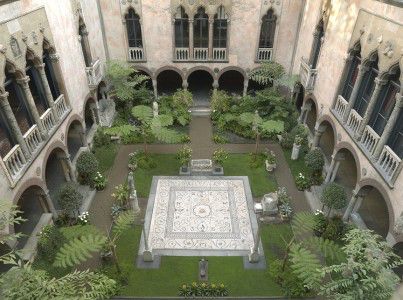The Isabella Stewart Gardner Museum is as much a community center as it is a place to view beautiful artwork and exquisite gardens. It boasts a state-of-the-art music hall, expansive show rooms and a top-notch educational studio. A sign outside the newest exhibition at the museum summarizes the mentality of the institution as a whole:

“We invite you to remove your shoes and sit on the carpet.”
It all once belonged to the founder of the museum, Isabella Stewart Gardner. When she opened the museum in 1903, Gardner’s purpose was not that of self-grandiosity or exhibitionism. To the contrary, she made it her life’s work to bring new, beautiful artistic experiences to those who otherwise would not have had the opportunity.
The green landscape that enshrines the main entrance of the museum is welcoming in its vitality. Once inside, visitors are greeted with an area affectionately referred to as the living room. Here, people can read from the bookshelves that encompass the area, relax after a long day of exploring or enjoy a treat from the cafe. MUSE was lucky enough to get a private tour of the museum.
“We’re not like a normal museum,” said Michael Busack, the Gardner’s media relations manager. “We have a curator of landscaping, we have a curator of music— so there’s a great deal here we have to offer.”
Calderwood Hall, designed by the world famous acoustician Yasuhisa Toyota, is less than a year old, but has already hosted some of the world’s greatest composers including cellist Yo-Yo Ma and pianist Paavali Jumppanen. The dynamic room also hosts multiple lecture series where a large projector descends from the balcony, transforming the music hall into a classroom. Complete with an Alaskan white cedar floor, surrounded by laser cut white oak walls and multi-level seating, Calderwood Hall is as pleasing to the eyes as it is to the ears.
Located at the epicenter of numerous colleges, the Isabella Stewart Gardner Museum provides students and other members of the community an opportunity to further their education. Beyond their acclaimed lecture series, the museum provides additional classes that allow for a deeper understanding of “art, education, landscape and music.” The programs are hands-on, encouraging the students to create their own pieces of art, which are put on display.
“We have to fill a role of educating the community and giving them a place to go,” Busack said. “A lot of students come here regularly and I think that’s something we pride ourselves on.”
At the heart of the museum is its historical collection. Consisting of over 2,500 pieces, the assortment of works range drastically in both style and genre. Today, over a century later, 200,000 people visit the museum annually. They are able to view everything from paintings by Rembrandt and Raphael to Flemish tapestries to 18th century Italian furniture. The works span three floors and are prominently displayed in a well-organized succession of rooms.
The most magnificent in the series of chambers is the newly renovated Tapestry Room. It is an expansive, cavernous room with dark cobblestone flooring and high ceilings. Supplemented with blood red curtains and tablecloths, the textiles match the fabric of the historic Italian furniture on display. The room is deeply romantic with its dark shades, subdued lighting and 18th century Venetian chairs. The Flemish tapestries are the focal point of the space. The large, beautiful works of art line the room in a series of five, each telling a vivid story about the illustrious Persian leader Cyrus the Great. Following with Gardner’s eclectic way of organizing her art, the Tapestry Room also includes works from both Spanish and American artists from varying time periods.
The museum is committed to the preservation of its artwork. The courtyard, located on the first floor, is a beautiful indoor garden, complete with plants grown from seed and sculptors from antiquity. The original pieces of artwork, however, do not look their age due to an extensive re-treatment project that is currently underway.

“We have a laser now that is similar to the same technology that they use to remove tattoos,” Busack said. “They can actually excite the molecules of dirt that are on the marble and zap them off without [negatively] affecting [the artwork].”
With only one sculpture left to finish, the museum’s sculptures appear as healthy and robust as they once did over 2,000 years ago.
The Gardner transcends the boundaries of genre, time periods and styles, culminating in a rewarding synthesis of art in its entirety.
This is an account occasionally used by the Daily Free Press editors to post archived posts from previous iterations of the site or otherwise for special circumstance publications. See authorship info on the byline at the top of the page.




I do not even know how I stopped up here, however I assumed this post was once great. I do not recognise who you might be however certainly you are going to a well-known blogger when you aren’t already 😉 Cheers!